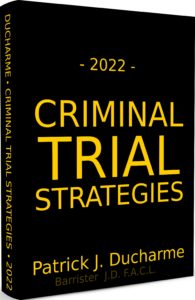Two jurors are selected from the jury panel and are initially selected to listen to the answers to the questions posed by the presiding Judge. Then, the triers of the issue are asked to decide if the juror under scrutiny should be excused for potential bias, or, should remain on the jury because the potential juror is not, in their opinion, biased. The two jurors are sworn on their oath, to properly try the issue. They must agree on their decision. If they cannot agree, the potential juror is not allowed to serve on the jury.
Since peremptory challenges have now been abolished, the only significant change in the challenge for cause procedure, as it existed prior to the 2019 amendments, is that the questioning of potential jurors has been taken out of the hands of counsel for the accused. The amendments require the trial Judge to ask the questions of the potential jurors.
Two “triers of fact” selected from the jury panel are still required to decide the issue. The triers are instructed by the trial Judge to decide the question of partiality or impartiality on the balance of probabilities. This means that potential bias does not have to be established beyond a reasonable doubt.
The decision-making is based on the less rigourous test; namely, on balance, is the potential juror likely to be biased? The decision of the two jurors on the question of bias must, however, be unanimous, that is, the two triers must both agree on the suitability of the potential juror.
If the two triers of this issue agree the potential juror is impartial, that juror is suitable for selection. If they agree that the potential juror is partial, that is, likely to be incapable of rendering a verdict without bias, that juror is unsuitable for selection and will be dismissed from further duty by the trial Judge.
Prior to the amendments a juror determined to be impartial and therefore suitable for jury duty could then be challenged peremptorily. However, the 2019 amendments abolished peremptory challenges and thus a juror determined to be impartial will be suitable to serve as a juror determining guilt or innocence.
Potential bias against the accused is only one ground of a challenge for cause. The other possible grounds are:
the juror’s name does not appear on the jury panel list.
the juror has been convicted of an offence and has been sentenced to a term of imprisonment for two years or more, and for which no pardon or record suspension is in effect.
the juror does not speak the official language of Canada, that is, the language of the accused or the official language of Canada in which the accused can best give testimony, or both.
the juror is not a Canadian citizen.
the juror is physically unable to perform properly the duties of a juror.
These additional possible grounds for dismissing a potential juror from jury duty are rarely used by our courts as challenges for cause. They are used, however, as a basis for the trial Judge dismissing a potential juror from the jury panel. Each juror on the jury panel is required to answer questions directed at these grounds prior to jury selection. Their completed jury form is provided to the assigned trial Judge. Any potential jurors who do not meet the criteria listed above are dismissed from the panel by the trial Judge before the proceedings begin.
The above is the an excerpt of Patrick J Ducharme’s book, Criminal Trial Strategies, available at Amazon or in bulk through MedicaLegal Publishing.
Read or listen to the Preface and Introduction and subscribe to Patrick Ducharme’s Youtube Channel.

